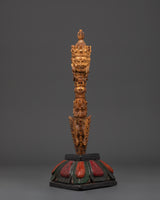
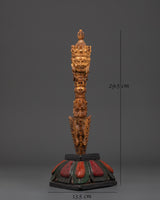
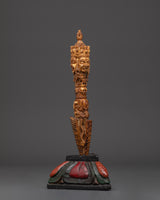
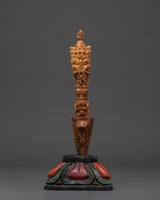
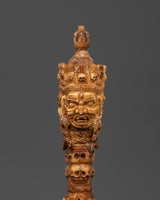
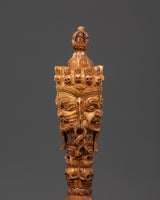
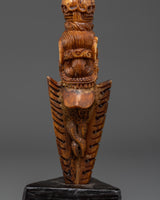
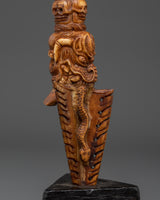
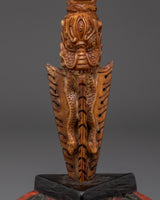
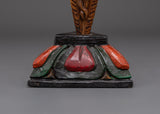
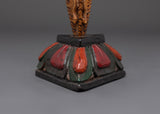
Tibetan Wooden Phurba | Tantric Ritual Dagger for Protection

100% AUTHENTIC

HANDMADE

FREE SHIPPING
Handcrafted Tibetan Wooden Phurba| for Spiritual Protection and Ritual Energy
--------------------------------------------
Size: 29.5cm (Height) x 13.5cm (Width)
Weight: 0.29kg
Materials: Wooden base, Acrylic Color, Buffalo Bone
--------------------------------------------
About The Ritual Item :
The Tibetan Wooden Phurba serves as a potent spiritual instrument in tantric rites and Vajrayana Buddhist ceremonies, designed to overcome negative energies and facilitate transformation. This 29.5cm tall and 13.5cm wide handcrafted bone dagger is adorned with bright acrylic paints that emphasize its sacred meaning. Its distinctive triple-edged blade symbolizes the triumph over the three fundamental delusions: ignorance, desire, and aversion, making it a cherished emblem of spiritual cleansing and divine protection. Harness this powerful tool to enhance your spiritual practice and shield yourself from negativity.
Lightweight at just 0.29kg, this Phurba dagger is ideal for altar use, ritual performance, or sacred display. In traditional practice, it is used by spiritual masters, shamans, and healers to ground unstable energies, cut through illusions, and protect both physical and spiritual spaces. The hand-carved details reflect ancient Himalayan artistry, with patterns and deity motifs that amplify the dagger’s vibrational power. Its colorful acrylic finish adds a vibrant touch, making it not only a sacred object but also a stunning piece of ritual art.
Introduction To The Phurba :
The ceremonial dagger (Sanskrit: Kila; Tibetan: phurba) is essential for expelling evil and is considered particularly effective in neutralizing the forces obstructing Tantric Buddhist practice. It has ancient origins, first appearing in the Indian Rig Veda as the core blade of the vajra used by Indra to destroy the primordial cosmic snake Vritra. Kila, derived from Sanskrit, was most likely associated with Vedic sacrifices. Meditation on the Vajrakila Tantra, an early Indian scripture first promoted in Tibet in the eighth century by Padmasambhava, one of the founding teachers of Tibetan Buddhism, is used to invoke the three-headed Vajrakila Buddha.
How to Set Up Your Buddhist Shrine?
Find a clean, quiet, and uncluttered spot.
Please set up an altar table and cover it with an altar cloth that calls to you.
Place your sacred item (statue, thangka, or a picture of Buddha) at the center.





















